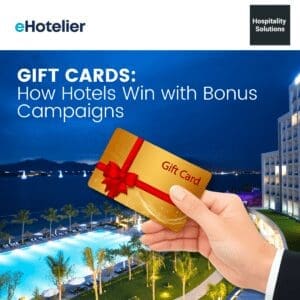 Each day, consumers are exposed to approximately 5,000 advertisements. From morning to night, our brains are flooded with corporate branding, selling products and services. Due to the intense competition for each consumer’s attention, every minute of every day, consistent and strategic branding and a strong first impression is especially important.
Each day, consumers are exposed to approximately 5,000 advertisements. From morning to night, our brains are flooded with corporate branding, selling products and services. Due to the intense competition for each consumer’s attention, every minute of every day, consistent and strategic branding and a strong first impression is especially important.
Ideally, a brand identity should be developed and communicated long before your public launch, but if your property didn’t have this luxury, don’t worry. It’s never too late to improve your property’s branding.
Before I share the four steps to improving your branding to more effectively position your brand in the mind of potential consumers with you, let’s clarify some important industry terms that can be confusing to anyone who isn’t working in marketing full-time:
Brand: “Unique design, sign, symbol, words, or a combination of these, employed in creating an image that identifies a product and differentiates it from its competitors. Over time, this image becomes associated with a level of credibility, quality and satisfaction in the consumer’s mind.”
Brand image: “The impression in the consumers’ mind of a brand’s total personality real and imaginary qualities and shortcomings. Brand image is developed over time through marketing/advertising campaigns with a consistent theme, and is authenticated through the consumers’ direct experience.”
Corporate Identity: “Combination of color schemes, designs, words, etc., that a firm employs to make a visual statement about itself and to communicate its business philosophy. A company’s corporate identity is comprised of various elements, including Òbuildings, dcor, logo, name, slogan, stationery, uniforms, website, etc.”
Now that we understand the basic terms associated with branding, let’s examine the four steps that you should take to improve your property’s branding today:
Step one: what sets you apart?
The first aspect to examine when establishing your company’s brand is that which differentiates your property from your competition. As a hotel, your focus should be on communicating the benefits you offer with your branding and other marketing materials as compared to other hotels in the same location with the same star rating.
Here’s an example: imagine you’re a five-star property on Fisher Island in Miami Beach, which is a private island only accessible by hotel guests and island residents. As a first step in establish your branding, you are trying to decide what makes your property different from the rest of the hotels in the Miami Beach area. As you would have already probably discovered, your key differentiator is that your property is exclusive, as only guests and residents have access to Fisher Island day-to-day. As many potential guests are looking for a unique, exclusive travel experience, it makes sense to use exclusivity as a key feature in your property’s branding.
Another important consideration is where you want to be as a brand in the future, not just where your property currently is. This allows you another barometer to evaluate all of your future marketing decisions against, as you make any strategic branding decisions; I.e. creating your collateral, developing ads, etc. to insure that you are always moving towards your ideal end-goal with each step.
Step two: who is your ideal guest?
Are you trying to attract corporate clients or leisure travelers? Is your perfect customer a backpacker or a luxury traveler? It’s important to know who you are trying to appeal to before you establish your brand imaging Ð again, in order to make sure that it properly reflects your key differentiators and helps you meet your end goal.
Also consider the location of your target audience. The specific geographical locale should be reflected in your branding as well. Consider if your target audience is international or location specific and what that means for your branding.
Step three: what does your brand look like?
Each property should choose which visual elements to include in their branding, again, based on their goals. Typical visual elements of a brand include the company’s name, logo, tagline, website design, collateral, etc.
In general, your logo should be simple and easy to recognize, no matter where consumers see it. Keep in mind that your tagline should create an emotional connection between potential guests and your property, not focus on your property’s key benefits. Alternatively, it should illustrate the most unique elements of your property that the consumer will experience during their stay. Overall, your brand’s visual elements should communicate with potential customers why they should choose to book your hotel over the competition on their next trip.
Step four: getting the message out
Once you’ve decided on the key elements to your brand and developed each piece of collateral to appeal to your ideal guests, it is time to start executing your marketing, advertising and public relations campaigns. Because you’ve identified your target audience, you can easily determine which medium will be most effective for promoting your property. Once you’ve decided on the best medium, just remember to be consistent with the visual elements of your brand and your messaging, across all channels.
Pitfalls to avoid
Here are some common branding mistakes many companies make:
Lack of investment. Many companies mistakenly don’t put enough value in the development of a strong brand and implementation of consistent branding throughout all internal and external touch points. Especially in a consumer-driven business, this is a big mistake. If potential guests don’t know or recognize your property, they are much less likely to book with you for their upcoming trip. Ê
Being too wordy. Effective copy (another word for text) is a great marketing tool. However, when it comes to branding, less is more. Your copy should be catchy and clever, using as few words as possible. The message should be very clear, so your tagline sticks in the minds of consumers.
Inconsistency. A lack of consistency is a huge reason that many company’s brands are ineffective for inspiring trust with potential customers, which will result in diminished bookings over time. At each marketing decision, you should ask yourself: ÒDoes making this decision reflect who my company is and what our brand communicates? Does it reflect where we want to be in the future?Ó If the answer is no, re-evaluate your decisions to maintain consistency across all touch points.
Too many or too frequent visual changes. A consistent, clear logo is an essential part of developing brand recognition with potential customers. If your logo is memorable and powerful, consumers should be able to identify your company simply by seeing the image, even without your tagline. By constantly editing your logo, you will confuse potential customers, making your marketing efforts less effective.
Promises you can’t deliver. If your brand communicates luxury and your customers arrive to find out that your property is a budget hotel without many amenities, your brand image will be tarnished, which will most likely result in a negative TripAdvisor review, which, as I’m sure you know, can result in decrease in your property’s ADR and RevPAR over time.
Flagged properties
The above advice is best applied to independent and boutique properties because flagged properties have less flexibility in how they apply their branding, which is likely already bound to a corporate image.
If you are a flagged property and need help more firmly establishing your property’s brand, the first step is to reach out to the marketing team at your corporate headquarters to find out what restrictions they have on the brand. While brand guidelines often govern the colors, messages, fonts, etc. of your marketing, the specific content and strategy will often be left up to each property Ð creating many significant opportunities to develop a more effective brand across many operational areas.
If you have any questions about the best ways to brand your property, feel free to contact me, personally, at any time at jenn@jlnpr.com.
By Jennifer Nagy, President of JLNPR Inc.
About JLNPR Inc.
 JLNPR Inc. is a full-service public relations and marketing agency that lives and breathes all facets of the travel technology industry. From online travel agencies to revenue management systems, tablet-based aviation automation solutions to IFE technology, hotels to airlines and everything in between, JLNPR uses our knowledge and experience to get your B2B travel technology company noticed by media, influencers and potential customers Ð and whenever possible, without the overused, often abused press release. In addition to traditional media relations outreach, we also ghost-write exciting, informational copy that will be published (in our client’s name) by top hotel industry media outlets Ð in order to increase your company’s visibility with potential customers, boost brand awareness and increase sales. To learn how to do your own PR for your company, download JLNPR’s free guide: How to Use Public Relations to Boost Your Sales – Without Blowing Your Budget. To find out more about JLNPR (including our services and out-of-the-box philosophy on press releases), please visit www.jlnpr.com.
JLNPR Inc. is a full-service public relations and marketing agency that lives and breathes all facets of the travel technology industry. From online travel agencies to revenue management systems, tablet-based aviation automation solutions to IFE technology, hotels to airlines and everything in between, JLNPR uses our knowledge and experience to get your B2B travel technology company noticed by media, influencers and potential customers Ð and whenever possible, without the overused, often abused press release. In addition to traditional media relations outreach, we also ghost-write exciting, informational copy that will be published (in our client’s name) by top hotel industry media outlets Ð in order to increase your company’s visibility with potential customers, boost brand awareness and increase sales. To learn how to do your own PR for your company, download JLNPR’s free guide: How to Use Public Relations to Boost Your Sales – Without Blowing Your Budget. To find out more about JLNPR (including our services and out-of-the-box philosophy on press releases), please visit www.jlnpr.com.
Ê















